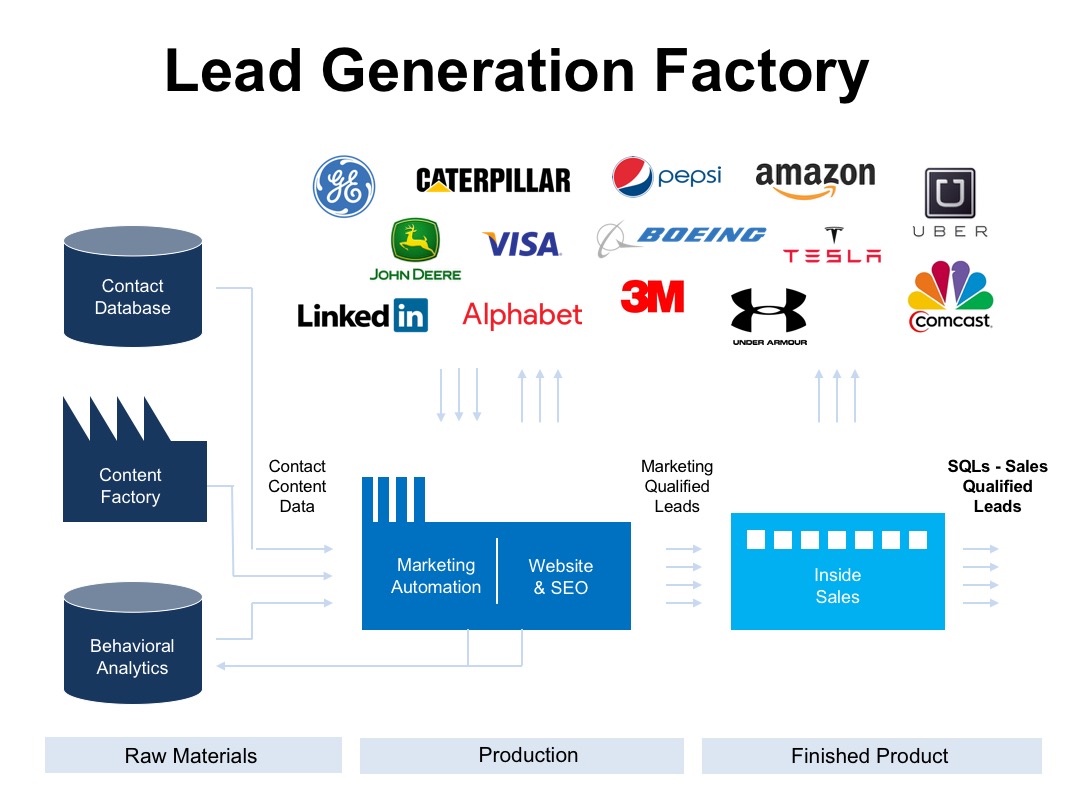Executives love to compare their marketing organizations to a machine or a factory. You input X dollars and after a period of time Y number of leads are generated. The factory model implies that the outcomes of marketing initiatives are predictable and reliable rather than being driven by luck or chance. But if marketers are to operate like factory workers they need to think about their lead generation programs in terms of a manufacturer. Marketers need to supply raw materials (inputs) to a production line which delivers outputs. Let’s compare how the lead generation process for enterprise software compares to a factory using the analogies of inputs, outputs, etc.
Raw Materials
Executives like to refer to budget as the primary input to the factory. I spend $X on marketing to get $Y of sales pipeline (leads). But typically the budget too raw of a material to input to the factory. We need slightly more refined materials for the lead generation factory. The real set of inputs are contacts and content – both of which can be purchased with budget.
First, we want to input to the factory a set of accurate contact data for each of the decision makers at all the accounts matching our ideal customer profile. Suppose we have 500 target accounts each of which has 10 key decision makers. For each of these 5000 contacts we would want both the email address, their direct dial phone number and additional profile details about their company.
Next, we need content. The content should be available in a variety of different formats, because different buyers like to consume content in different ways. Some like to read (white papers, infographics, slide shows). Others like to watch/listen (explainer videos, podcasts or webinars). The best type of content is the kind that doesn’t try to sell or market your product at all. Instead, the content provides useful information that helps your prospective customers do their day-to-day job.

Production Line
The contacts and content move into an assembly line with a production schedule. Each week a different set of content is pushed out to a pre-defined set of contacts. Week One might target IT buyers with a value proposition around cost savings. Week Two might target Human Resources with a value proposition around talent management. Week Three might target Legal with a value proposition around regulatory compliance. Week Four might target Manufacturing with a value proposition around quality management.
The intermediate output of the lead generation factory is data – about who is interested (contacts) and in what (content). With today’s marketing technology (website analytics, marketing automation, social media) you can collect enormous amounts of data with relatively little spend. For example, you can send an eBook out to 1000 HR contacts via email then monitor how many opened the email, clicked through the email and downloaded the PDF. You can send an invitation for a webinar out to 5000 IT managers then monitor how many register and attend. Put simply, contacts that read, watch or download the content you distributed have expressed some level interested and should be tagged as Marketing Qualified Leads (MQLs).
Finished Products
Many of these MQLs (the output of the production line) are not ready for the next step in the supply chain. In order to be forwarded onto the next part of the factory an MQL will need to meet a certain quality score. The quality score typically aligns with the who they are and what they have done. For example, an MQL contact may have attended a webinar; downloaded a white paper; or visited key sections of the website. But most highly scored MQLs have done more than one of these activities with some regular level of frequency.
The best prospects should be targeted for one-to-one personalized engagement. In most cases, this is a good old fashioned phone call, but it could be outreach via email or social media as well. Most software companies have a Lead Development Rep (LDR) proactively reach out to each of their MQLs to assess their readiness for the next step in the supply chain. For example, an LDR might discover that a prospect may be qualified as having a definitive need, budget, authority and timing. These prospects will be reclassified as Sales Qualified Leads (SQLs) then packaged up for delivery to the sales team. The remaining MQLs that were not reachable or were not ready for the next step in the supply chain will be returned to inventory at the warehouse.









